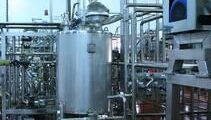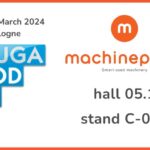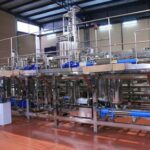Extraction lines transform fruits and vegetables into puree or concentrate, which is then processed to create juices, creams, sauces, and more. Initially, fresh fruits and vegetables are sorted, with high-quality ones being used for fresh sales, canning, or dehydration. Second-grade fruits and vegetables are processed into puree, cream, concentrates, juices, flavor powders, etc.
In Europe, 30% of fruit and vegetable production is further processed into various products. In many other countries and agricultural regions, this is considered waste. Each year, significant quantities of mangos go to waste, which could be processed into different products apart from fresh mangos.
Each extraction line varies depending on the fruit or vegetable being processed. Fresh fruits and vegetables are primarily washed, cleaned of leaves, and pitted. From here, two different extraction technologies can be applied.
Hot Extraction
Traditional hot extraction technologies first deactivate natural enzymes through a thermal treatment that slows down cell deterioration. This is followed by a turbo-pulper, macerator, juicer, or press, which separates the puree from the skin and seeds.
Hot extraction procedures are typically used for stone fruits and rely on prior enzymatic deactivation or cooking of the fruit with the skin, followed by a turbo-pulper that removes the skin and defects. This technology has the advantage of performing enzymatic deactivation prior to grinding, resulting in higher viscosity. However, it has been surpassed by the application of cold extraction at low temperatures with very short residence times and subsequent enzymatic deactivation, resolving issues with viscosity and the transfer of skin components to the final product.
Hot extraction technologies can compromise the flavor, color, and taste of the puree because pulp and seed contaminants are transferred to it, and the fruit is cooked to deactivate the enzymes.
Cold Extraction
Cold extraction technologies are the latest application in extraction lines. The cold extraction process enhances the flavor and texture while preserving the natural qualities of fresh products.
In the cold extraction process, the entire fruit is processed at room temperature, removing stems, seeds, and skin. The resulting puree is then heated for a short period to deactivate enzymes. This extraction process precedes enzymatic deactivation, allowing less pulp and seed contamination to pass into the puree. The result is higher production yield and improved puree quality.
Yields obtained often exceed those obtained with hot extraction, such as in the case of strawberry puree, where the yield reaches 96%. A different extraction line is required for each type of fruit, and each case must be analyzed individually. For instance, in the case of mango puree, a pre-treatment is required to prevent the pulp’s oil from entering the puree.
A typical extraction process includes:
- Fruit and vegetable washing machine
- Sorting machine
- Peeling machines
- Inspection conveyor, manual or with visual technology
- Storage systems
- Sheet conveyor
- Extraction machines using cold or hot extraction technologies
- Enzyme deactivation systems
- Pasteurizers
- Aseptic filling for bags ranging from 200 to 1000 kg.
MachinePoint sells cream extraction equipment for all types of fruits and vegetables, offering both cold and hot extraction for fruits and vegetables, in addition to the traditional hot break and cool break for tomato paste.

Key issues: Used extraction lines for fruits and vegetables with MachinePoint
Extraction lines for fruit and vegetable processing operate through a series of stages that include cleaning, selection, crushing or cutting, juice or pulp extraction, and eventually pasteurization or sterilization, depending on the desired final product. These lines are designed to optimize efficiency and the quality of the final product.
MachinePoint offers extraction lines that can process a wide variety of fruits and vegetables, such as apples, oranges, tomatoes, carrots, among others. With these lines, it is possible to obtain products such as juices, concentrates, purees, pulps, among other derivatives.
MachinePoint can help you optimize fruit and vegetable processing in your business by offering specific used machinery tailored to your needs. Additionally, we can provide other services and offer personalized advice to optimize the layout and operation of your processing plant.
Yes, at MachinePoint, we have a team of experts in used machinery for food processing who can advise you on machinery purchases. We will analyze your requirements and offer you options that fit your needs, budget, and business goals. Additionally, we provide technical support and assistance throughout the entire process of purchasing and commissioning the machinery.





